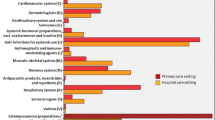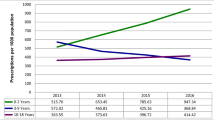Abstract
Background
Population-based drug utilization databases that comprehensively capture an entire population’s drug dispensing are scarce resources for epidemiological studies. This study aimed to examine the prescription-dispensing rates in children in British Columbia (BC) and describe the differences in the dispensing of medications in BC versus children in the United States (US) and Europe.
Methods
The study population was children aged 0–17 years in BC (n = 855,541). Children with at least one prescription dispensed in 2007 were identified using the provincial outpatient prescription dispensing database. All prescriptions were grouped on the basis of the Anatomical Therapeutic Chemical (ATC) classification system. Prevalence of drug dispensing was calculated in each age group, gender, and therapeutic class.
Results
Fifty-five percent of BC children were dispensed at least one prescription in 2007. Antibacterials for systemic use, dermatological corticosteroids, and drugs for obstructive airway diseases were commonly dispensed in each age group. The percentage of children who received psychoanaleptics was two to five times higher than rates reported in European countries, but 30% lower than rates reported in the US.
Conclusions
Half of the BC population <18 years received at least one prescription in 2007. Significant variations in drug dispensing were highlighted between BC, the US, and Europe. Future studies are needed to examine the outcomes of the prescribing in terms of benefit and harm. A variety of factors (e.g., disease prevalence rates, drug prescribing preferences) are likely to contribute to disparate dispensing of specific drug classes and should be principal factors in the investigation.

Similar content being viewed by others
References
Statistics Canada (2011) Population by sex and age group, by province and territory. http://www.statcan.gc.ca/tables-tableaux/sum-som/l01/cst01/demo31a-eng.htm. Accessed 1 February 2012
Khaled LA, Ahmad F, Brogan T, Fearnley J, Graham J, MacLeod S (2003) Prescription medicine use by one million Canadian children. Paediatr Child Health 8 (Suppl A):6A–56A
Demers V, Melo M, Jackevicius C et al (2008) Comparison of provincial prescription drug plans and the impact on patients' annual drug expenditures. CMAJ 178:405–409. doi:10.1503/cmaj.070587
British Columbia Ministry of Health (2012) All PharmaCare Plan descriptions. http://www.health.gov.bc.ca/pharmacare/plans/index.html. Accessed 1 February 2012
Sturkenboom MCJM, Verhamme KMC, Nicolosi A et al (2008) Drug use in children: cohort study in three European countries. BMJ (Clin Res Ed) 337:a2245–a2245. doi:10.1136/bmj.a2245
British Medical Association (2012) Media centre—general practitioners. http://www.bma.org.uk/press_centre/pressgps.jsp#.T8H9zlJlLOy. Accessed 1 February 2012
Protti D, Smit C (2006) The Netherlands: another European country where GPs have been using EMRs for over twenty years. http://www.healthcareimc.com/bcovers/PDFS/TheNetherlands.pdf. Accessed 1 February 2012
Cazzato T, Pandolfini C, Campi R, Bonati M (2001) Drug prescribing in out-patient children in Southern Italy. Eur J Clin Pharmacol 57:611–616. doi:10.1007/s0022800356
Brownell M, De Coster C, Penfold R, et al (2008) Manitoba child health atlas update. http://mchp-appserv.cpe.umanitoba.ca/reference/Child_Health_Atlas_Update_Final.pdf. Accessed February 2012
British Columbia Stats (2006) Statistical profile of aboriginal peoples. Aboriginal peoples compared to the non-aboriginal population with emphasis on labour market and post secondary issues. http://www.bcstats.gov.bc.ca/data/cen01/abor/aborbc.pdf. Accessed 1 February 2012
BC Stats (2011) P.E.O.P.L.E software. http://www.bcstats.gov.bc.ca/StatisticsBySubject/Demography/PopulationProjections.aspx. Accessed 1 February 2012
WHO Collaborating Centre for Drug Statistics Methodology (2010) ATC/DDD index. http://www.whocc.no/atc_ddd_index/. Accessed 1 February 2012
Clavenna A, Berti A, Gualandi L, Rossi E, De Rosa M, Bonati M (2009) Drug utilisation profile in the Italian paediatric population. Eur J Pediatr 168:173–180. doi:10.1007/s00431-008-0725-y
Thrane N, Sorensen HT (1999) A one-year population-based study of drug prescriptions for Danish children. Acta Paediatr 88:1131–1136
Schirm E, van den Berg P, Gebben H, Sauer P, Jong-van D, den Berg L (2000) Drug use of children in the community assessed through pharmacy dispensing data. Br J Clin Pharmacol 50:473–478. doi:10.1046/j.1365-2125.2000.00275.x
Faber A, de Jong-van den Berg LT, van den Berg PB, Tobi H (2005) Psychotropic co-medication among stimulant-treated children in the Netherlands. J Child Adolesc Psychopharmacol 15:38–43. doi: 10.1089/cap.2005.15.38
Fegert JM, Kolch M, Zito JM, Glaeske G, Janhsen K (2006) Antidepressant use in children and adolescents in Germany. J Child Adolesc Psychopharmacol 16:197–206. doi:10.1089/cap.2006.16.197
Knellwolf AL, Deligne J, Chiarotti F et al (2008) Prevalence and patterns of methylphenidate use in French children and adolescents. Eur J Clin Pharmacol 64:311–317. doi:10.1007/s00228-007-0401-6
Volkers AC, Heerdink ER, van Dijk L (2007) Antidepressant use and off-label prescribing in children and adolescents in Dutch general practice (2001–2005). Pharmacoepidemiol Drug Saf 16:1054–1062. doi:10.1002/pds.1430
Zito JM, Safer DJ, Berg LT, et al (2008) A three-country comparison of psychotropic medication prevalence in youth. Child Adolesc Psychiatr Mental Health 2:26. doi:10.1186/1753-2000-2-26
Clavenna A, Andretta M, Pilati P et al (2011) Antidepressant and antipsychotic use in an Italian pediatric population. BMC Pediatr 11:40. doi:10.1186/1471-2431-11-40
Breton JJ, Bergeron L, Valla JP et al (1999) Quebec child mental health survey: prevalence of DSM-III-R mental health disorders. J Child Psychol Psychiatry Allied Discip 40:375–384
Froehlich TE, Lanphear BP, Epstein JN, Barbaresi WJ, Katusic SK, Kahn RS (2007) Prevalence, recognition, and treatment of attention-deficit/hyperactivity disorder in a national sample of US children. Arch Pediatr Adolesc Med 161:857–864. doi:10.1001/archpedi.161.9.857
Ford T, Goodman R, Meltzer H (2003) The British Child and Adolescent Mental Health Survey 1999: the prevalence of DSM-IV disorders. J Am Acad Child Adolesc Psychiatry 42:1203–1211. doi:10.1097/00004583-200310000-00011
Lecendreux M, Konofal E, Faraone SV (2010) Prevalence of attention deficit hyperactivity disorder and associated features among children in France. J Atten Disord 15:516–524. doi:10.1177/1087054710372491
Huss M, Holling H, Kurth BM, Schlack R (2008) How often are German children and adolescents diagnosed with ADHD? Prevalence based on the judgment of health care professionals: results of the German health and examination survey (KiGGS). Eur Child Adolesc Psychiatry 17(Suppl 1):52–58. doi:10.1007/s00787-008-1006-z
Dopfner M, Breuer D, Wille N, Erhart M, Ravens-Sieberer U (2008) How often do children meet ICD-10/DSM-IV criteria of attention deficit-/hyperactivity disorder and hyperkinetic disorder? Parent-based prevalence rates in a national sample—results of the BELLA study. Eur Child Adolesc Psychiatry 17(Suppl 1):59–70. doi:10.1007/s00787-008-1007-y
Panei P, Arcieri R, Vella S, Bonati M, Martini N, Zuddas A (2004) Italian attention-deficit/hyperactivity disorder registry. Pediatrics 114:514
Centres for Disease Control and Prevention (CDC) (2003) Mental health in the United States: prevalence of diagnosis and medication treatment for attention-deficit/hyperactivity disorder. CDC-MMWR Weekly 54:842–847. http://www.cdc.gov/mmwr/preview/mmwrhtml/mm5434a2.htm. Accessed 1 February 2012
Ministry of Children and Family Development (2003) Child and youth mental health plan for British Columbia. http://www.mcf.gov.bc.ca/mental_health/pdf/cymh_plan.pdf. Accessed 1 February 2012
National Institute for Health and Clinical Excellence (2006) Methylphenidate, atomoxetine and dexamfetamine for attention deficit hyperactivity disorder (ADHD) in children and adolescents. http://www.nice.org.uk. Accessed 1 February 2012
Vitiello B (2008). An international perspective on pediatric psychopharmacology. Int Rev Psychiatry 20(2):121–126. doi:10.1080/09540260801887710
Heyman I, Santosh P (2002) Pharmacological and other physical treatments. In: Rutter M, Taylor E (eds) Child and adolescent psychiatry, 4th ed. Blackwell Science, Oxford, pp 998–1018
Taylor E, Dopfner M, Sergeant J et al (2004) European clinical guidelines for hyperkinetic disorder—first upgrade. Eur Child Adolesc Psychiatry 13(Suppl 1):I7–I30. doi:10.1007/s00787-004-1002-x
American Psychiatric Association (1994) Diagnostic and statistical manual of mental disorders, 4th ed. American Psychiatric Association, Washington DC
American Academy of Pediatrics (2001) Clinical practice guideline: treatment of the school-aged child with attention-deficit/hyperactivity disorder. Pediatrics 108:1033–1044
National Institute for Health and Clinical Excellence (2009) Depression in children. Clinical knowledge summaries. http://www.cks.nhs.uk/depression_in_children/management/scenario_depression_in_children#344099006. Accessed 1 February 2012
Son SE, Kirchner JT (2000) Depression in children and adolescents. Am Fam Physician 62:2297–2308
Hsia Y, Maclennan K (2009) Rise in psychotropic drug prescribing in children and adolescents during 1992-2001: a population-based study in the UK. Eur J Epidemiol 24:211–216. doi:10.1007/s10654-009-9321-3
Watson R (2003) EU health ministers reject proposal for limited direct to consumer advertising. BMJ (Clinical Res Ed) 326:1284. doi:10.1136/bmj.326.7402.1284-b326/7402/1284-b
Mintzes B, Barer ML, Kravitz RL et al (2003) How does direct-to-consumer advertising (DTCA) affect prescribing? A survey in primary care environments with and without legal DTCA. CMAJ 169:405–412
Ufer M, Meyer SA, Junge O et al (2007) Patterns and prevalence of antidepressant drug use in the German state of Baden-Wuerttemberg: a prescription-based analysis. Pharmacoepidemiol Drug Saf 16:1153–1160. doi:10.1002/pds.1405
Health Canada (2000) Risk of important drug interactions between St. John's wort and prescription drugs. http://www.hc-sc.gc.ca/dhp-mps/medeff/advisories-avis/prof/_2000/hypericum_perforatum_hpc-cps-eng.php. Accessed 1 February 2012
Lawvere S, Mahoney MC (2005) St. John's wort. Am Fam Physician 72:2249–2254
Marra F, Monnet DL, Patrick DM et al (2007) A comparison of antibiotic use in children between Canada and Denmark. Ann Pharmacother 41:659–666. doi:10.1345/aph.1H293
de Jong J, van den Berg PB, de Vries TW, de Jong-vanden Berg LT (2008) Antibiotic drug use of children in the Netherlands from 1999 till 2005. Eur J Clin Pharmacol 64:913–919. doi:10.1007/s00228-008-0479-5
Matthys J, De Meyere M, van Driel ML, De Sutter A (2007) Differences among international pharyngitis guidelines: not just academic. Ann Fam Med 5:436–443. doi:10.1370/afm.741
Gould LM, van der Meer JWM, Harbarth S, Monnet DL (2007) Cultural and socioeconomic determinants of antibiotic use. In: Gould LM, van der Meer J (eds) Antibiotic policies—fighting resistance. Springer, Berlin, pp 29–40
British Columbia Health Services (2003) Guidelines and protocols. Diagnosis and management of sore throat. http://iskra.bfm.hr/upload/sore-throat-british-colombia.pdf. Accessed 20 May 2012
US Department of Health and Human Services (2005) National Guideline Clearinghouse. Acute pharyngitis in children 2-18 years old. http://guideline.gov/content.aspx?id=25757. Accessed 20 May 2012
Dagnelie C, Zwart S, Balder F, Romeijiders A, Geijer R (1999) NHG-standaard Acute Keelpijn (eerste herziening). [Guideline on acute tonsillitis of the Dutch College of General Practitioners, first revision.] Huisarts Wet 42:271–278.
Scottish Intercollegiate Guidelines Network (2010) Management of sore throat. http://www.sign.ac.uk/guidelines/fulltext/117/index.html. Accessed 15 May 2012
Palmer DA, Bauchner H (1997) Parents' and physicians' views on antibiotics. Pediatrics 99(6):E6
Clavenna A, Bonati M (1996) Differences in antibiotic prescribing in paediatric outpatients. Arch Dis Child 96:590–595. doi:10.1136/adc.2010.183541
Rossignoli A, Clavenna A, Bonati M (2007) Antibiotic prescription and prevalence rate in the outpatient paediatric population: analysis of surveys published during 2000-2005. Eur J Clin Pharmacol 63:1099–1106. doi:10.1007/s00228-007-0376-3
Financial disclosure and conflict of interest
The authors have no personal or financial relationships, academic competition, or intellectual commitments that could cause a real or perceived conflict of interest with respect to the research discussed in the manuscript.
This research did not have sponsor.
Author information
Authors and Affiliations
Corresponding author
Rights and permissions
About this article
Cite this article
Zhang, T., Smith, M.A., Camp, P.G. et al. Prescription drug dispensing profiles for one million children: a population-based analysis. Eur J Clin Pharmacol 69, 581–588 (2013). https://doi.org/10.1007/s00228-012-1343-1
Received:
Accepted:
Published:
Issue Date:
DOI: https://doi.org/10.1007/s00228-012-1343-1




